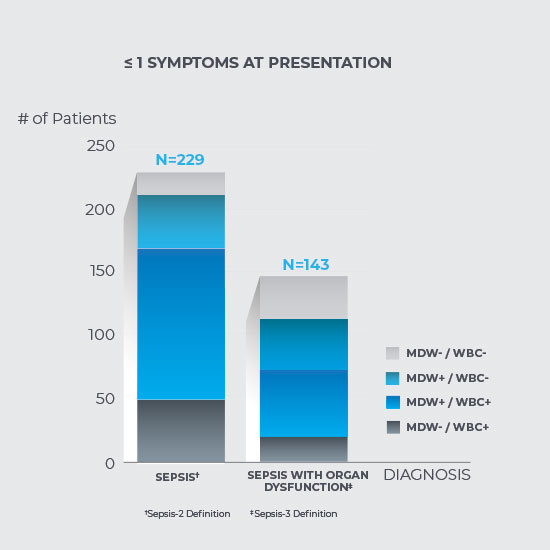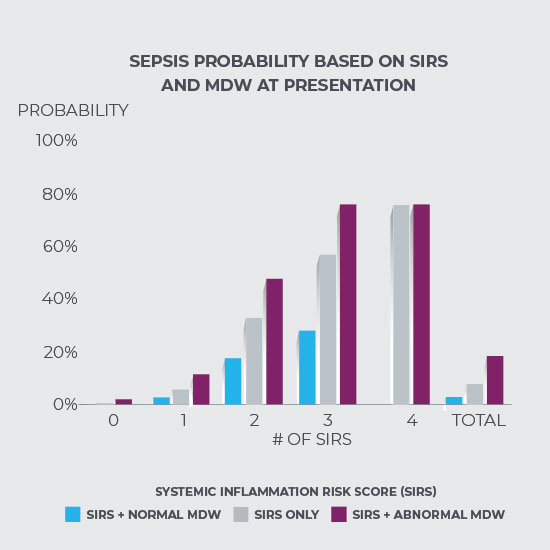Challenges of Identifying Sepsis
A Global Crisis
Over 49
million people worldwide are affected by sepsis1
Costly
$24
billion healthcare-related costs to manage sepsis annually in the U.S.2
Difficult to Diagnose
Over 30%
of septic shock patients present with vague symptoms and may be missed by the EMR alerts3
Novel Sepsis Biomarker in the Emergency Department
Sepsis Detection Using Monocyte Distribution Width
Monocyte Distribution Width (MDW) is a measure of increased morphological variability of monocytes in response to bacterial, viral or fungal infections. The quantitative analysis of MDW has received regulatory clearances as an aid for early detection in adult patients with or developing sepsis in emergency departments.
Considered with other signs and symptoms, the value of MDW helps differentiate sepsis from non-septic presentations, including non-infectious systemic inflammatory response.4 This sepsis biomarker is automatically reported with the complete blood count (CBC) with differential* for adult emergency department patients, without any additional test ordering.

Clinical Evidence Findings
The performance of MDW for sepsis detection has been evaluated in the prospective observational study of 2,158 emergency department patients in three large academic centers in the U.S.
Increased Sensitivity
Sensitivity of technologies is critical. When considered alone, the discriminating power of MDW is similar to that of White Blood-cell Count (WBC).
However, when MDW is considered together with WBC, MDW may add to the sensitivity and specificity of sepsis detection, as part of the standard assessment protocol in the emergency department.4,5


The Challenge of Low Symptom Presentation
Diagnostic uncertainty is a major challenge for patients presenting to the emergency department with a low number of signs and symptoms.
- 60% of emergency department patients who were diagnosed with sepsis in a pivotal study presented with zero or one symptom used for sepsis screening
- Abnormal MDW was present in up to 70% of septic “gray zone” patients4,5
MDW Modulates the Probability of Sepsis
Considered with other parameters, abnormal MDW at presentation increases the odds of sepsis.
The study determined that, when considered along with the standard physiologic parameters at the time of patient presentation, abnormal values of MDW signify a 4-6x increase in probability of sepsis diagnosis. In patients with a low level of symptoms and highest diagnostic uncertainty at presentation, abnormal MDW increased the odds of sepsis by ~3x.6

Resources on Sepsis Progression and Detection
MDW Adds Value to Sepsis Detection
Novel protocols and biomarkers are being studied to improve sepsis detection time. A clinical study evaluates the diagnostic accuracy of MDW for early sepsis detection.
The Role of Monocytes in the Progression of Sepsis
Find out how MDW can aid emergency department physicians in sepsis-related clinical decision-making by measuring morphological changes in monocytes.
BARDA Funding to Aid in Early Sepsis Detection
Beckman Coulter receives BARDA funding to develop a next-generation analytic algorithm to predict and detect sepsis earlier, with the goal of reducing sepsis mortality rates through earlier intervention.
The value of MDW is that it provides physicians with an earlier indication of sepsis during the initial encounter, which is especially important when a patient’s symptoms are mild and alternative diagnosis are being considered.
ELLIOTT CROUSER, M.D., PROFESSOR OF CRITICAL CARE MEDICINE
OHIO STATE UNIVERSITY WEXLER MEDICAL CENTER



